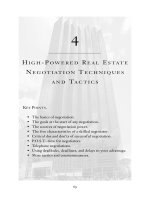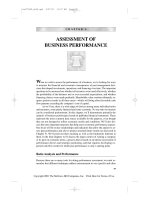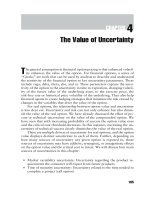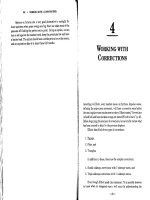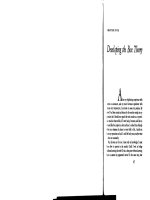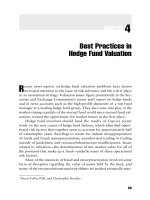Chapter 4
Bạn đang xem bản rút gọn của tài liệu. Xem và tải ngay bản đầy đủ của tài liệu tại đây (115.7 KB, 13 trang )
Chapter 4
Dynamic Games of Incomplete Information
An example: a signaling game model of a labor market
A model of a labor employment market model
Suppose that there are a firm and an applicant (a labor).
The firm is not sure about the abilities of the applicant, i.e., the firm does not know whether the
labor is a skilled labor or not.
-1
0
Not employ
0
Employ
1
Not employ
Employ
The firm’s information set
The applicant has Low ability ( be Unskilled)
The applicant has High ability
(be Skilled)
1/3
2/3
N
The firm’s expected payof
Employ : (2/3) ×(-1) + (1/3) ×(1) == 1/3.
Not Employ : (2/3) ×0 + (1/3) ×0 = 0.
Hence, the firm does not employ the applicant (labor) and get its payof of 0.
However, If the firm could hire the applicant with high ability,
it could have got the payof of 1and the applicant could have got the job.
So, “NOT Employ” is inefficient.
( This phenomenon is called an “adverse selection” in economics. )
Introducing a qualification (or a career) system to the model
A qualification (or a career) is called a signal in game theory.
Notations
Type-H : the applicant with high ability
Type-L : the applicant with low ability
Assumptions
It cost 2 for Type-H to acquire the qualification (the signal).
It cost 5 for Type-L to acquire the qualification (the signal).
If the applicant is employed by the firm, then he (or she) gets wages of 3.
It is assumed that this wage level does not depend on the ability of the applicant.
If the applicant is not employed, then he (or she) gets wage of zero.
The game tree with a qualification system (a signaling game)
3, 1
1, 1
Employ
applicant, firm
Type-H applicant
Employ
H
Not acquire
acquisition
Not
applicant, firm
Not
of the qualification
0, 0
-2, 0
1/3
The firm’s information set: the applicant has the
The firm’s information set: the applicant does
not have the qualification
qualification
N
2/3
3, - 1
-2, - 1
Employ
Not acquire
acquisition
L
Not
0, 0
of the qualification
Type-L applicant
Employ
Not
-5, 0
Let’s consider the equilibrium of this dynamic incomplete information game.
The equilibrium is referred to as a perfect-Bayesian equilibrium (P.B.E.).
The equilibrium concept requires following conditions.
Requirement 1 (consistency) The firm’s beliefs in its information sets must be consistent with the behaviors of both
types of the applicant.
Requirement 2 (rationality) Given the consistent beliefs above, the firm makes its best choice in each information set.
Given the choices above made by the firm, each type of the applicant makes its best choice.
Can ( Type-H acquires the qualification, Type-L does not )
be a perfect Bayesian equilibrium strategy?
In this case, diferent types choose diferent action, respectively,
which is called a separating equilibrium.
Consistent belief
with the separating equilibrium strategy of each applicant’s type
3, 1
Employ
applicant, firm
1, 1
Type-H applicant
0
1
H
Not acquire
acquisition
Not
Employ
applicant, firm
Not
of the qualification
0, 0
-2, 0
1/3
The firm’s information set: the applicant has the
The firm’s information set: the applicant does
not have the qualification
qualification
N
2/3
3, - 1
Employ
-2, - 1
acquisition
Not acquire
Employ
of the qualification
L
Not
0, 0
1
Type-L applicant
0
Not
-5, 0
The firm’s best choices when the consistent beliefs above are given.
3, 1
Employ
applicant, firm
Type-H applicant
0
1
H
Not acquire
acquisition
Not
Employ
1, 1
applicant, firm
Not
of the qualification
0, 0
-2, 0
1/3
The firm’s information set: the applicant has the
The firm’s information set: the applicant does
not have the qualification
qualification
N
2/3
3, - 1
Employ
Employ
acquisition
Not acquire
-2, - 1
of the qualification
L
Not
0, 0
1
Type-L applicant
0
Not
-5, 0
The best choice of each type of the applicant
when the firm’s choices above are given.
3, 1
1, 1
Employ
applicant, firm
Type-H applicant
Employ
H
Not acquire
acquisition
Not
applicant, firm
Not
of the qualification
0, 0
-2, 0
1/3
The firm’s information set: the applicant has the
The firm’s information set: the applicant does
not have the qualification
qualification
N
2/3
3, - 1
-2, - 1
Employ
Not acquire
acquisition
L
Not
0, 0
of the qualification
Type-L applicant
Employ
Not
-5, 0
Therefore, we have confirmed that the following pair of strategies (and beliefs) constitutes a perfect
Bayesian equilibrium.
Type-H acquires the qualification.
The applicant
Type-L does not acquire the qualification.
If the applicant has the qualification, then the firm employs her (him).
The firm
If the applicant does not have the qualification,
then the firm does not employ her (him).
A perfect-Bayesian Nash Equilibrium (the separating equilibrium)
3, 1
1, 1
Employ
applicant, firm
Type-H applicant
0
1
H
Not acquire
acquisition
Not
Employ
applicant, firm
Not
of the qualification
0, 0
-2, 0
1/3
The firm’s information set: the applicant has the
The firm’s information set: the applicant does
not have the qualification
qualification
N
2/3
3, - 1
-2, - 1
Employ
Not acquire
L
Not
0, 0
1
Employ
acquisition
of the qualification
Type-L applicant
0
Not
-5, 0
Summary
Consider a situation where an asymmetric information among players might induce inefficiency.
Introducing some qualification system that is costly for a part of players, the economic welfare of the situation
could be improved.
Applications of signaling games: a school career (in labor economics); foreign direct investments (in
international economics), a peacock in his pride (in theoretical biology) , a military parade or saber-rattling (in
political science or international relationships), etc.
Dynamic incomplete information
Key words: perfect Bayesian equilibrium, consistent belief, rationality,


